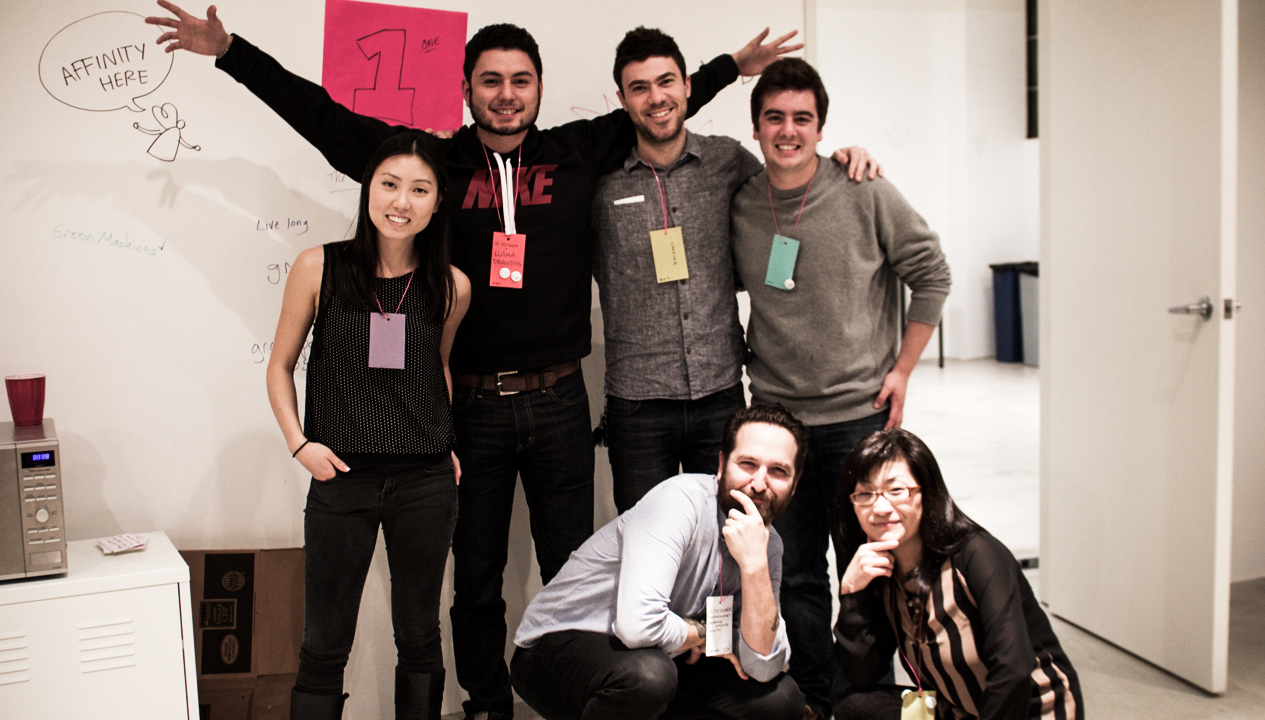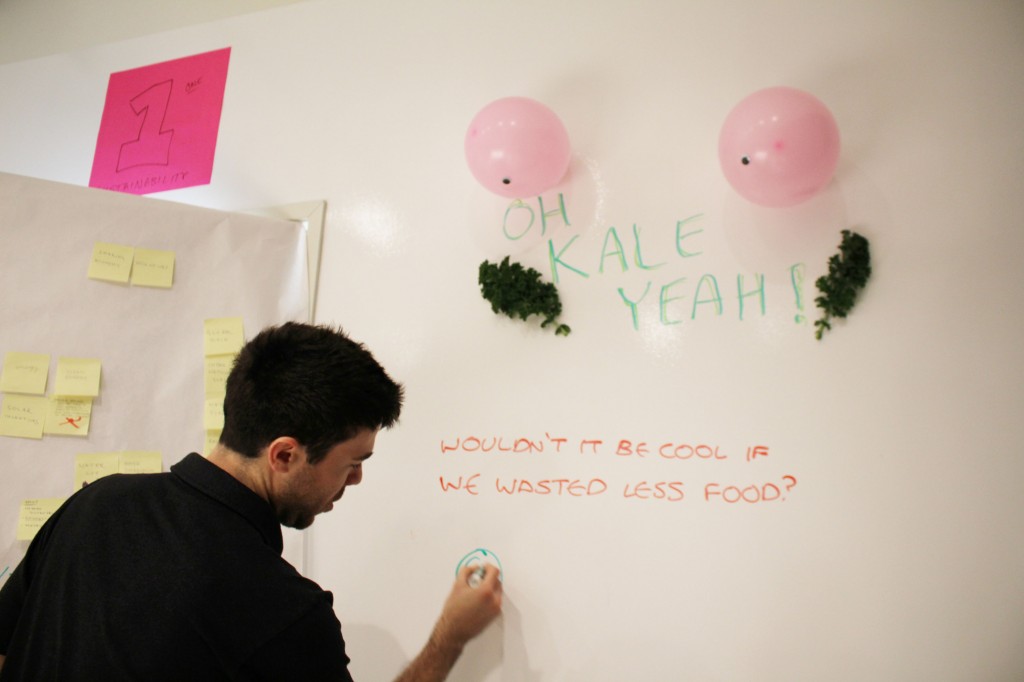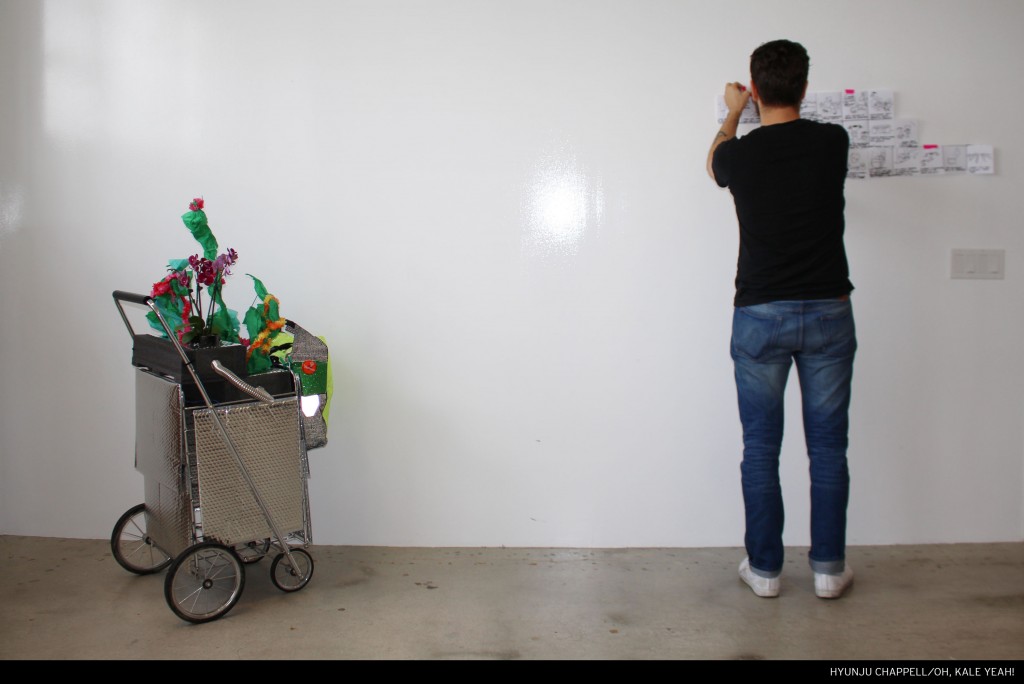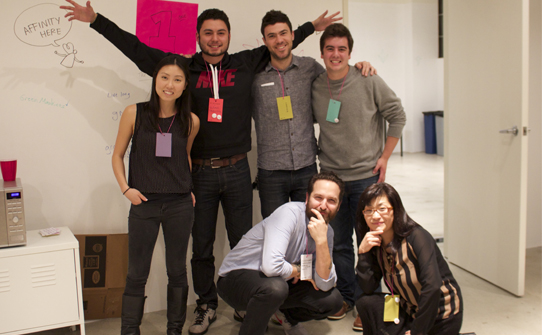In this blog post, HyunJu Chappell (MDP+Field MFA ’14) reflects on what happened when Angelenos gathered for 48 hours of human-centered design at the Los Angeles Service Design Jam. They were among thousands “jamming” simultaneously during the 2015 Global Service Jam taking place in at least 95 cities.
HyunJu graduated from Media Design Practice’s new Field program, which combines design with social engagement. For her thesis studies, she lived twice in Uganda, where she employed design and collaboration to explore youth political agency. Before coming to Art Center, HyunJu was a visual journalist working in news and features design at The Washington Post. Her latest thrills have included programming servo motors, printing on a showbill letterpress, and savoring a mochi-lato. Check out her thesis, follow her Tweets or say “hello.”
DAY 1, A NEW WORLD
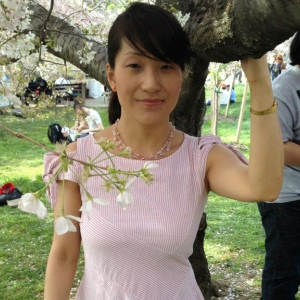 What would you do if a client gave you this as a design brief? A cryptic origami sketch with arrows looping round and round. Huh? It didn’t state an objective; it didn’t specify an audience. I had received open-ended, challenging design briefs at MDP charrettes, but this brief didn’t contain a single word. Still, the image was the big reveal: the Secret Theme of this year’s Global Service Jam. It was released Feb. 27 in 40 countries, from Russia to the island nation of Mauritius. We were now charged to form teams, conduct ethnography and build a prototype — all by the global deadline of 3 p.m. Sunday, March 1. As we began, people tossed out phrases used in unfamiliar ways: affinity diagrams, pain points, touchpoints, journey maps. I was being immersed in the lexicon of service design thinking. It didn’t take long, though, to translate these terms to methods and concepts used in Media Design Practices.
What would you do if a client gave you this as a design brief? A cryptic origami sketch with arrows looping round and round. Huh? It didn’t state an objective; it didn’t specify an audience. I had received open-ended, challenging design briefs at MDP charrettes, but this brief didn’t contain a single word. Still, the image was the big reveal: the Secret Theme of this year’s Global Service Jam. It was released Feb. 27 in 40 countries, from Russia to the island nation of Mauritius. We were now charged to form teams, conduct ethnography and build a prototype — all by the global deadline of 3 p.m. Sunday, March 1. As we began, people tossed out phrases used in unfamiliar ways: affinity diagrams, pain points, touchpoints, journey maps. I was being immersed in the lexicon of service design thinking. It didn’t take long, though, to translate these terms to methods and concepts used in Media Design Practices.
It reminded me of the 1st time I heard an MDP critique and was surprised by their style of vocabulary. As in many business environments, MDP’s Wind Tunnel studio has an evolving shared language. I had become accustomed to hearing terms like: dystopic, discursive, speculative, positionality, and meta. Some terms cross over to design thinking’s terminology: ideation and prototyping; that’s MDP’s DNA.
At the jam, I couldn’t help but wonder if I was hearing merely buzzwords. I hate to admit that I briefly questioned whether to return the next day. Soon, though, I was pulled into the creative flow, and decided to stay. I’m glad I did.
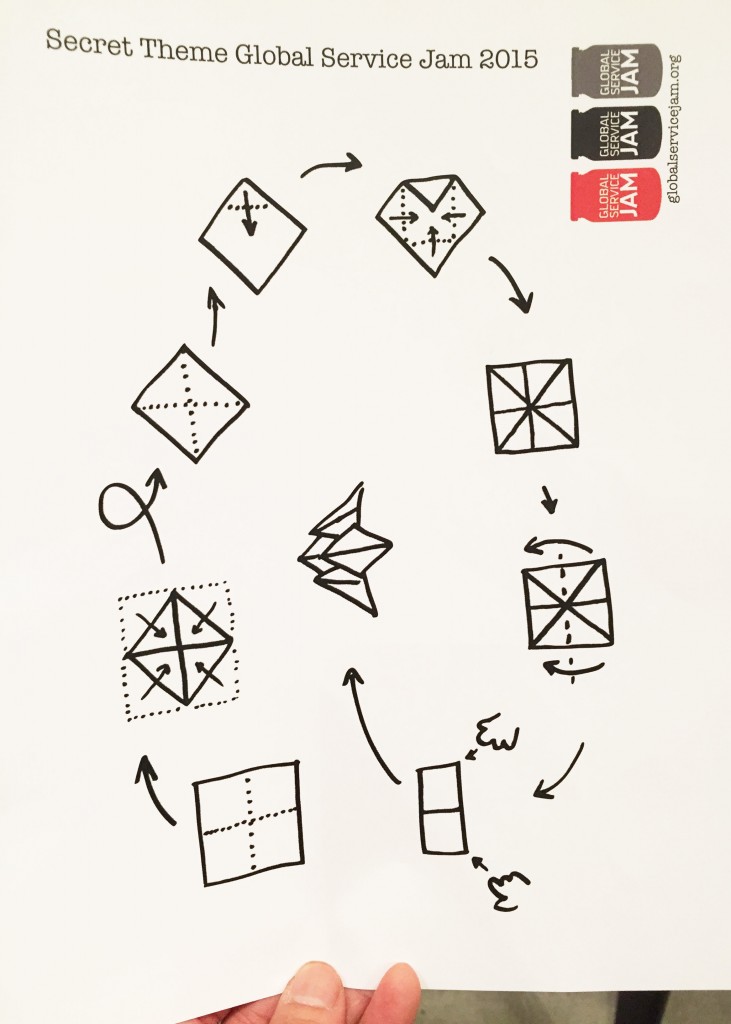 Ideas flowed all around me on that 1st night. People riffed about possible meanings of the Secret Theme. Countless Post-its went up on the floor-to-ceiling white boards at General Assembly. Then we started meeting each other by exchanging question cards asking: “Wouldn’t it be cool if … ?” One example: “Wouldn’t it be cool if we could all understand every language?”
Ideas flowed all around me on that 1st night. People riffed about possible meanings of the Secret Theme. Countless Post-its went up on the floor-to-ceiling white boards at General Assembly. Then we started meeting each other by exchanging question cards asking: “Wouldn’t it be cool if … ?” One example: “Wouldn’t it be cool if we could all understand every language?”
You could entertain utopic, improbable ideas at the jam. As part of this anything-goes spirit, the jam encouraged the donning of silly hats worldwide.
I joined the sustainability team, and we voted on the name “Oh, Kale Yeah!” Then everyone went home for the night — This was not Art Center — and I didn’t know what we might end up making.
I had a clearer picture, though, about service design. From the presentations, I thought service design focused on how to best meet people’s needs at touchpoints of interaction. One jam organizer, John Ayers, said he thinks service design trumps all other types of design because it encompasses them all: product, environmental, UX, IxD, etc.
DAY 2, FULL THROTTLE
In the morning, my team skillfully and quickly sorted ideas about sustainability through affinity mapping and theme identification. We honed in on our challenge statement asking: “Wouldn’t it be cool if we wasted less food?” Next we hopped on a bus to the Grand Central Market, and carried out user research. We also posted social media queries.
We returned with a bounty of insights. A man whose friends call him “Country” called us over, and outlined his stringent efforts to plan out each meal so he doesn’t waste. Single people described how and when they end up throwing out leftovers, despite their best intentions. Online, an MDP classmate shared an article stating that one-third of all the food produced in the world goes uneaten.
The next step took us to the critical core of the event: synthesizing. We detailed user personas, identified their pleasure and pain points, and drew storyboards of their user journeys. For a broader view, we drew a timeline of the backstage and frontstage points of food waste at multiple levels of farming, distribution and consumption. By afternoon, we had formed our problem statement, which aimed to “take the waste out of household food purchasing.”
Now we just needed an implementation plan. By 5pm, sketches of savvy apps and speculative Smart Carts scattered our table, without a clear winner. Some of us felt brain-fried; others were just getting started.
DAY 3, MAGIC
Pressure was on. Word came that our technology could be fantastical, and we felt liberated. We started riffing on each other’s ideas and, suddenly, we had a complete service plan. At 10:30, we just started making. We turned a shopping cart into a hydroponics and composting system for the home. A box became a drone for delivering other produce and transporting unused foods. By 2:30, we had completed a storyboard, script, filming, voice-over narration and editing. We rolled in our prototypes and screened our video Home Harvest to laughter from fellow jammers and appreciation from the mentors.
The Final Presentations were a celebration (and the most easy-going crit I’d had in 2.5 years).
VALUE PROPOSITION
By the end, I was surprised by how I came to understand the Secret Theme. To me, the steps of the origami folding represented the powerful process of 6 minds coming together. I had jammed with a professional synthesizer, a manager of a co-working space, a UX/graphic designer, a social media marketer, and a social impact analyst. Outside of my grad program, it was heartening to see people of many backgrounds devote a weekend to tackling needs around them.
The jam’s final speaker, Matthew Manos (MDP MFA 2012), was a consolidating figure for me. He speaks both languages of MDP and service design. He shared an amusing analogy about design spirit animals and also stressed the importance of theory. He closed with a principle often espoused in the Wind Tunnel: “Proving a problem is more important than proving a solution.”
I appreciated how jammers asked questions about complex issues. Around the world, maybe they’ll continue making, iterating, and asking: “Wouldn’t it be cool if …?”
